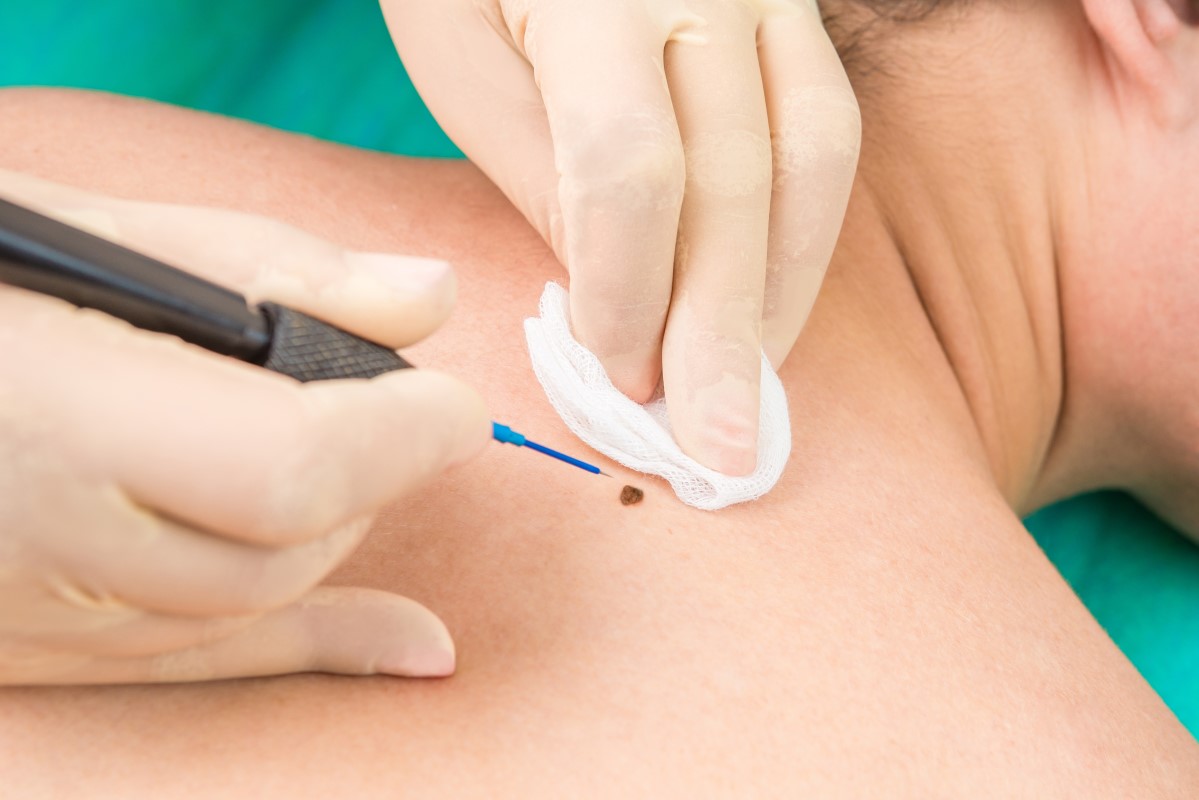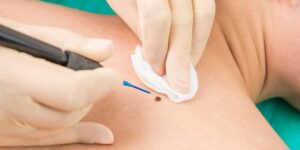SKIN CANCER
Skin Cancer Detection And Management
This page is dedicated to information around skin cancer. Find out about the different types of skin cancers, how likely they are to develop and why it’s so important to practice active skin protection in our Australian sun.
It is never too early to recognise a potential skin cancer. We recommend annual skin checks with one of our doctors who has a special interest in skin cancer medicine. The frequency of checks may vary depending on your risks and skin type. To organise your skin check appointment please call the clinic or book online. Please avoid the use of moisturisers and make-up on the day of your examination.
The Skin Clinic operates a proactive digital reminder system and will usually contact you via email or sms to remind you when you’re due for your skin check. Please ensure your email address and mobile number is up to date in our records. If for some reason you do not receive a reminder please call us or an appointment or book online.
What Is A Skin Cancer?
Skin cancer is an uncontrolled and unusual growth of abnormal cells in the skin. Skin cancer occurs when normal skin cells are damaged, for example, cumulative exposure to ultraviolet radiation (UV) from sunburn. About 98% skin cancers in Australia are caused by exposure to UV radiation of the sun. About 2% of skin cancers(including melanoma) occur where there has been no sun exposure. Therefore, you must see your skin doctor if you are worried about a new or changing spot/mole even if it is in an area that has never been sunburnt (or never sees the sun).
There are three main types of skin cancer:

Basal Cell Carcinoma (BCC)
- BCC is most common of all skin cancers, making up around 70% of non-melanoma skin cancers.
- BCC commonly appears on the head, neck and upper body.
- It appears as red, pale, pearly flat or raised lesion.
- A BCC may bleed and become inflamed causing ulceration.
- If left untreated, a BCC will continue to slowly spread and cause large sores(ulceration).
- Though BCCs do not usually spread to other parts of the body, it is best to treat early to prevent ulceration and damage to the affected area.
Melanoma
- Melanoma is least common skin cancer but it is the most dangerous.
- It mostly arises as a dark, irregularly pigmented patch or lump on the skin
- Melanoma may also (rarely) present as a pink to red patch or lump.
- Commonly melanoma arises as a brand new spot.
- It could also arise in an existing mole that changes in size, shape or colour.
- Most cases can be successfully treated if caught early, but it can be fatal if treatment is delayed.
- The earlier the melanoma is diagnosed, the better the chance of survival.
Squamous Cell Carcinoma (SCC)
- SCC is the second most common skin cancer, accounting for about 30% of non-melanoma skin cancers.
- SCCs usually develop on sun exposed areas of the body, such as the head, neck and hands.
- An SCC may look like a sore and may be tender to touch.
- It is not as dangerous as melanoma but can be deadly if left untreated on areas like lips, ears, scalp or temples.
Did You Know?

What Causes Skin Cancer?
The main cause the skin cancer is exposure to ultraviolet (UV) radiation from the sun. The Australian climate and fair skin in particular are a poor mix. Other sources of UV radiation, such as solarium tanning beds, also causes skin cancer.
In rare situations, skin cancer appears where you never have been exposed to sun. The available research suggests that while skin cells are often damaged in childhood, it may be sun exposure in adulthood that triggers these damaged cells to turn into cancerous lesions
Who Is At Risk?
Anyone can develop skin cancer, regardless of their skin type, colour or general wellbeing. This is why it is so important to find a reliable skin cancer doctor with whom you can discuss your risk and plan regular skin surveillance.
One in three Australians can expect to develop some type of skin cancer in their lifetime. Early detection is the best way to improve the outcome for these cancers. Melanoma is by far the most dangerous type of skin cancer. To assess your individual risk of melanoma, see the melanoma risk calculator on the Victorian melanoma service website.

When Should I Worry About A Mole Or Spot?
You should seek urgent medical advice from your skin cancer doctor if you have a mole or spot that;
Who Should Get Skin Check Ups?
Skin Cancer Diagnosis
Initial Consultation
At your initial skin check, a doctor with specific postgraduate training in skin cancer diagnosis will take a thorough history and then conduct a comprehensive examination of your skin surfaces, assessing suspicious lesions.
For a proper examination you will be asked to undress to your underwear (be assured, your privacy is protected at all times). We use a hand held dermatoscope (basically a strong microscope for viewing the skin) to check your skin for unusual lesions, spots or blemishes.
Suspicious lesions are noted and recorded via18 megapixel high resolution digital SLR photography and digital dermatoscope (skin surface microscope) photography/mole scanning.These are stored in our state of the art Canfield Mirror Mole Mapping software for future reference and comparison.
We also record digital images of your back and face as baseline photographs for future comparison. We do this regardless of whether you have suspicious lesions as these areas are more prone to skin cancer.
If there is any need for follow up visits, biopsy or skin surgery we will advise you as soon as possible. In some cases, suspicious lesions require a skin biopsy first and surgical removal under local anaesthetics. This may be done at our clinic or in some cases a referral is to a relevant specialist centre.
Depending on your risk of developing future skin cancers we may also recommend Total Body Photography(TBP) and mole mapping, either total body or a specific body region.
Tips For Skin Cancer Prevention
Check Your Own Skin Regularly
Even skin that has never been exposed to the sun has the potential to develop skin cancer. Regular check ups mean early detection, and early detection is the key to beating skin cancers. Most skin cancers are detected by people themselves or by close family members.
Unlike many other cancers, skin cancer is often visible, making it easier to detect in the early stages. We recommend you undertake your own full body skin check regularly, because skin cancers can occur on parts of the body not exposed the sun.
If you are worried about any mole, spot or freckle, please see your skin cancer doctor for an advice.

Protect Your Skin From Sun Damage
Protect your skin from ultraviolet (UV) radiation as 98% of skin cancers are caused by the sun. We recommend using UV index to know when to protect your skin from sunburn. The UV index shows the intensity of the UV radiation emitted by the sun. It’s part of most weather reports these days.
The daily SunSmart UV Alert identifies the sun protection times for more than 200 locations across Australia. You can check the SunSmart UV alert on the weather page of most daily Newspapers, via a free app for smartphones or on the SunSmart website.
When the UV index is 3 or above, we recommend you




